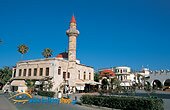 |
 |
 |
Arrivals – Departures |
|
 |
Athens International Airport – Eleftherios Venizelos |
|
|
 |
 |
 |
|
 |
 |
 |
Better check the weather... |
|
 National Observatory of Athens National Observatory of Athens |
 Poseidon Poseidon |
 Ntua.gr Ntua.gr |
 Accuweather Accuweather |
 Weather Underground Weather Underground |
|
|
 |
 |
 |
|
|
|
 |
 |
| Kos (capital) |
  |
|
|
|
 The town of Kos counts about 15.000 permanent residents; it is built in the northeastern end of the island and lies flat, flooded with greenery.
The town of Kos is built under the European architectural standards, since it has been rebuilt by the Italians after the earthquake that took place in 1933. The entire town is an archaeological and historical museum; all around Kos town there are signs of the past, various monuments, medieval buildings, Turkish mosques; there are wide streets lined with trees, and large squares and as for the town planning, it is enviable. Kos town is the ideal place for bicycling since bicycles are the favourite means of transportation for the locals. |
| |
| Worth seeing |
• The ancient town; it lies near the harbour of Kos. It's an area full of temples and public buildings that cover a period of 2000 years of permanent residence and it is divided into three sections: the west ern section, the central section and the eastern section.
• The castle of the knights; it was built by the knights of Saint John in the 15th century and it is in a good condition. An arched bridge connects the castle with the square where the famous plane tree of Hippocrates and the Ôurkish mosque of Gazi Hassan Pasha stand.
• The plane tree of Hippocrates; it is a huge tree, and the inhabitants claim that it was planted by Hippocrates, the greatest doctor in antiquity, who used to teach and examine his patients under its shade. It is not exactly the same plane tree but its offshoot and its branches are supported by pillars.
• The Mosque of Gazi Hassan Pasha; it was built in 1786 by materials from ancient buildings.
• The Defterdar Mosque, in the main square - Eleftherias Square; it is the place of worship for the Moslems who live on the island.
• The Forum Gate; it was built in 1391. The road, full of bars, leads to Eleftherias Square.
• The building of the Club, in in the main square - Eleftherias Square; on the façade of the building there is an inscription with verses from the National Anthem of Greece and the date of the union of the Dodecanese with Greece carved upon it.
• The Asklepeion; situated west of Kos, the Asklepeio is the most significant archaeological building on the island. It is built into three levels connected with stairs. It is located on the top of a hill from where the view is indeed fascinating. The excavations here took place in 1902 by the German archaeologist R. Herzog. The Asklepeion was built in the 3rd century BC. The second level is where the Temple of Kiparissios Apollo (4th century BC) used to be. The highest level was constructed in the 2nd century BC and included a large temple of Doric style dedicated to Asclepios. On the vestibule of it was built, during the Christian times, the Church of the Virgin Mary of "Tarssos". There is a capital that used to be the altar with the initials ICXP. Moreover, the visitor could visit the International Hippocratic Institute of Kos, or International Institute of Hippocrates, that stands in the area of the Asklepeio.
• The Archaeological Museum of Kos; the Museum exhibits sculptures from the Hellenistic and Roman Era, statuettes, signs, etc. Visitors can admire the mosaic with the welcome of Asclepiosm the tomb stones and the statues of Demeter and of Hippocrates (Tel.No.: 28326). |
| |
| Where to swim |
| • At the beaches of Lambi, Faros and Atlandis. To the east side of the island, at the beach of Psalidi and at the beach of Agios Fokas. |
|
|
|
|
|
 |
 |
|
|
|
 |
 |
 |
|
|
|
 |
 |
|
|


